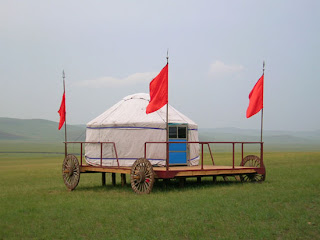Welcome to the Ontario Yurt Project!! Building my First Yurt in 2010 and my second in 2011 they are now where I call home! This is a blog about living simply through nature!
Monday, October 4, 2010
Yurt Down 2010
I was sad to see it go, but I begin the large yurt build in less than a month! so I am looking forward to it!!
Thursday, September 9, 2010
Mongolia By Karl Schuler

Karl Schuler has done an amazing job with his photography of Mongolia, not to mention the whole world, please take a minute to enjoy some of his great work! http://photo.net/photodb/folder?folder_id=781569
Wednesday, September 8, 2010
5 Good Reasons to Consider Living in a Yurt!
Originally found @ planetgreen.discovery
5 Reasons Why It Yurts So Good
1. Yurts are the Real Green Deal
TreeHugger reports on Dave Masters (of the Luna Project) and his life in a yurt: "We talk all the time about living with less; Dave lives in 706 square feet with off grid power, a composting toilet, a shower and a full kitchen and didn't give anything up at all to live in comfort and style. When you live in 706 square feet you don't need much to run it; he collects water from his roof, power from the sun and wind, heat from sustainably cut wood. He spends about six hundred bucks a year for his propane barbeque, gas for his chainsaw and log splitter and that is about it."
| Jupiter Images |
2. Yurts are Eco-Friendly
Living in a yurt can help us re-connect to nature, sure, but the literal structure of a traditional yurt is also nature-friendly. The materials are recyclable and should you decide to pick up and move your yurt, there's no residual damage to the ground because no permanent foundation is used.
3. Yurts Have Stood the Test of Time
"They've been used throughout history by nomads in Central Asia," writes Molly Edmonds at HowStuffWorks.com. "Evidence of fourth century B.C. yurts has been discovered, and the oldest complete yurt was found in a 13th century Mongolian grave. The structures were well-suited for the nomadic lifestyle because only a few oxen were required to carry a family's entire home. But the structure was also easy to heat in the cold Mongolian winters where temperatures might reach 50 degrees below Celsius (-58 degrees Fahrenheit)."
| Jupiter Images |
4. Yurts Can Be Modern, Too
By combining the durable yurt concept with a few modern updates, we now have something called a yurta. This form of micro-architecture has optimized the original yurt concept to create a shelter that is steadfast, quick to install, light-weight, easy to transport, minimal in footprint.
5. Yurts are Cheap
The Nomad Yurt, for example, costs a little over $5,000 (US) for a 22-foot diameter version with an insulated skin. If a few comrades pooled together for land, you'd have yourself a yurt commune and giant step forward and away from the unsustainable life.
Tuesday, September 7, 2010
Traditional Ger

The Traditional Ger has been used since the 4th century, what an amazing home, still just as efficient as it ever was! Valerie Sartor from polarinertia.com has taken a lovely set of photographs cataloging some of the nomadic people of today, they live very similar to their ancestors did for centuries, I recommend checking out the article and series of photos located on here http://www.polarinertia.com/feb08/yurt01.htm
Cheers,
The past Yurt

Since this is my first post here, I doubt to many will be reading it... But that being as it is I should explain some of the history behind the Ontario Yurt Project.
While reading a book written about survival the author spoke about living for some time in a Yurt, curious as I had never heard the term used before I decided to do some research of my own, originally I had thought it was similar to a wigwam built by the native Canadians, much to my surprise it was much more then I could have ever imagined!
My simple research which I had originally done for my understanding took a new shape, that of obsession! for weeks to follow (my friends and family can contest!) I spoke only of Yurts, I watched every video on YouTube, read every blog, Yurt manufactures online sites, and purchased several key books. I had a new goal set in mind, to build my own Mongolian Yurt in a traditional manner.

Originally I wanted to construct my Yurt using the most natural and minimal of designs, cutting the Khana from small trees, using natural insulation (straw, cattail down) etc, but I found that working a 9-5 Job working for the man & constructing an all natural Yurt was not going to fly, so I decided to take the easier rout, purchase my materials but construct the yurt in traditional fashion.
After 3 months of working during evenings and weekends, the yurt started to take shape, I was fortunate enough to have received two large sheets of canvas from my Uncle for the covering of my yurt, and the door was given to me by my father who works in the industry, the rest was constructed out of mostly 2"x6" and rope.
my 12' Yurt has been set up for most of the summer, it held up exceptionally well, and was quite popular, I will be taking it down for the winter months as I wont be around it to clear off any snow that could potentially cause damages (I would like to monitor it for myself). I plan to set it back up again this Spring along with what I hope is a finished 24' Yurt for permanent residency.
The ultimate purpose of this blog is to record my process and help those who wish to start living a free and sustainable lifestyle though the means of a Yurt!
Good luck and happy Yurting!
